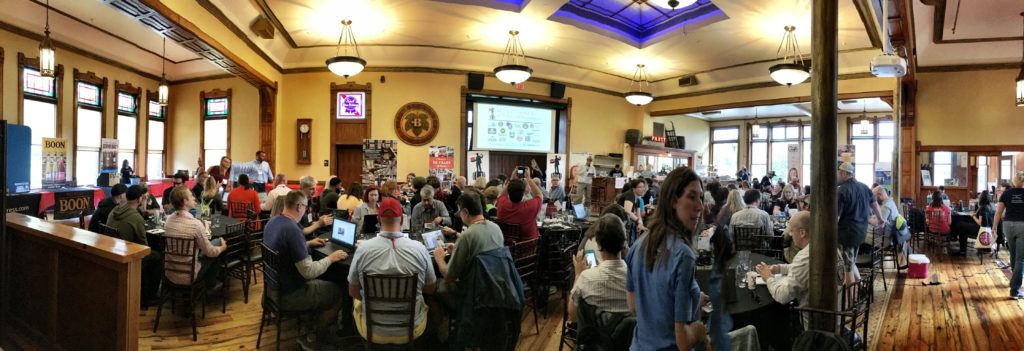2017 Beer Bloggers & Writers Conference
About a month ago 150 bloggers and writers (including myself) descended upon Milwaukee for the 2017 Beer Bloggers & Writers Conference. I’m happy to report that Milwaukee and its beer supply survived!
 What is the Beer Bloggers and Writers Conference?
What is the Beer Bloggers and Writers Conference?
Founded in 2010, the Beer Bloggers & Writers Conference (BBC) attracts approximately 150 attendees from throughout North America to network, learn, and taste beers. A different city hosts the conference each year. The conference is one of the premiere events for bloggers and writers to interact with beer industry leaders.
As noted by the BBC,
“Beer bloggers and writers are not only passionate about beer. They are energized by writing about beer, breweries, and the people that make up the beer industry. They are motivated by communicating their views to their communities via their blogs, industry magazines, and social media.
Because of this, beer bloggers and writers are a crucial aspect of the industry, a connection between brewers and consumers. They are often the voice of the industry.”
The Importance of Beer Bloggers and Writers
Beer drinkers, like all consumers, have grown skeptical of traditional, straight forward advertising. Instead beer consumers have turned to family, friends, social media and apps (like BeerAdvocate.com and Untappd), and micro-influencers (bloggers) to make recommendations. Consumers feel that micro-influencers are much more honest and genuine.
In fact, statistics presented by Red Door Full Service Marketing & Advertising Agency in 2014 showed the following:
a. 86% of market influencers blog;
b. 81% of readers trust bloggers;
c. most of all, 61% of readers are influenced in their purchases by bloggers.
Hence, beer bloggers and writers wield powerful influence with both consumers and industry brands.
Some Key Takeaways From This Year’s Conference
First of all, this year’s conference was packed with information. So there is more information than I can possibly post and keep you reading. Hence, here are just a few of the many fascinating beer industry facts that I think you’ll find interesting and relevant. Most importantly, you can read these facts in the short span of drinking a beer.
 Best Place at the Historic Pabst Brewery Hosted the 2017 Beer Bloggers & Writers Conference
Best Place at the Historic Pabst Brewery Hosted the 2017 Beer Bloggers & Writers Conference
1. The U.S. Beer Industry is More Vital to Our Economic, Social, and Cultural Lives Than Ever Before
Julia Herz, the Craft Beer Program Director for the Brewers Association, opened the conference. Here is some of the information she conveyed and my perspective about a few of the implications of this information.
 Julia Herz, Craft Beer Program Director for the Brewers Association, opens the 2017 Beer Bloggers & Writers Conference
Julia Herz, Craft Beer Program Director for the Brewers Association, opens the 2017 Beer Bloggers & Writers Conference
a. “The U.S. is the #1 destination for beer on planet earth.” – Julia Herz
Hence, the U.S. beer industry is a major attraction for international tourists. More importantly, while visiting the U.S. these tourists spend their money on more than just beer. They also pay for accommodations, food, tours, rental cars, mementos, and more. Often, tourists are not just taking vacations – they are taking beer-cations.
b. “Beer: American Drinkers’ Beverage of Choice” – Julia Herz
As reported by Julia Herz, 2016 beer sales totaled $107.6B. That number is almost equal to the sales of U.S. wine and other spirits sales combined. In addition, small and independent craft breweries contributed $23.5B to that total.
According to the National Beer Wholesalers Association (NBWA) , the overall beer industry contributes more than $350B in economic output, which is equal to nearly 1.9% of the U.S. Gross Domestic Product. Overall, the U.S. beer industry creates nearly 2.23 million American jobs. Brewers and beer importers directly employ 64,745 Americans. Also, America’s beer distributors provide nearly 135,000 jobs with solid wages and great benefits to employees at more than 3,000 facilities, located in every state and congressional district across the country. In addition, each job in the brewing industry generates 33 full-time equivalent jobs in other industry sectors such as wholesalers, retailers, manufacturers, and farmers.
Consequently, beer sales are a major contributor to our economy’s health and vitality. In addition, small and independent breweries are major contributors to our local economies. As a result, the proliferation of small and independent breweries plays a major role in revitalizing small communities and their surrounding areas.
c. “Small and independent craft brewers use their craft beers as a cause for other causes.” – Julia Herz
According to the Brewers Association, small and independent craft breweries made $71M in 2014 charitable contributions. That amount equates to $20, 664 per brewery and $3.25 per barrel of beer produced. As a result, local communities benefit from having small and independent craft brewers.
In a more recent example, many large and small brewers have stepped up to aid the victims of Hurricane Harvey. As noted by the Brewers Association, “Houston’s Great Heights Brewing and Pedernales Brewing Company in Fredericksburg are giving back financially, by donating portions of their profits to the relief efforts. Some have even put themselves in the line of danger, such as 8th Wonder Brewery, who used its oversized brewery truck to rescue flood victims and deliver them to safe ground.” In addition, Oskar Blues stopped canning beer altogether at its Longmont, Colo. brewery in order to partner with the CAN’d Aid Foundation to fill 88,800 cans of water to be sent to Texas. These are just a few of the many examples of breweries supporting the victims of Hurricane Harvey.
d. “Consumption of craft beer is biased toward eating occasions.” – Julia Herz
Why? Because according to a Nielsen CGA On Premise User Survey, 49% of the time that we drink craft beer, eating food is also involved. Since eating occasions act as a catalyst for socializing with family, friends, and business acquaintances, beer plays an important role.
2. The Long-term Outlook for Beer is Strong and Evolving
Lester Jones, Chief Economist for the NBWA, provided information that indicates the beer industry is strong but changing. Lester Jones tracks the economic factors that impact the beer distribution industry and alcohol policy decisions at the federal, state and local levels. He evaluates and develops primary industry data, including economic impact, tax impacts, sales and volume data.
 Lester Jones, Chief Economist for the NBWA – photograph courtesy of NBWA
Lester Jones, Chief Economist for the NBWA – photograph courtesy of NBWA
a. “The U.S. Department of Treasury’s Alcohol and Tobacco Tax and Trade Bureau (TTB) permitted 8,301 U.S. Breweries from 1990 to June 2017.” – Lester Jones
Since the TTB permitted 250 breweries for 1990, the numbers show a staggering 97% growth. Overall, the U.S. currently has 3.5 permitted breweries per 100,000 people. While the growth has been strong, there is room for more expansion.
b. “The U.S. demographics favor alcohol.” – Lester Jones
– “10,000 Baby Boomers turn 65 each day. They are the new “Leisure Force.” What will they do with their time?”
– “12,000 Millennials turn 21 each day. They are the new work force. What will they do with their money?”
– The “economy is at full employment.”
c. The Alcohol Industry understands that it is “not just a competition for a drink, but a competition for your time.” – Lester Jones
To effectively attract future consumers, drink-related businesses like brewpubs and taprooms need to provide reasons for the consumer to stay longer and return again (and again). These businesses must create an experience that includes options such as food, tours, music, yoga, special events, and more.
Summary
Overall, the beer industry is one of the U.S.’s largest and most impactful industries. These impacts span the economic, social, and cultural aspects of our lives. Furthermore, small and independent brewers are a major component of that impact.
The alcohol industry is postured for a strong and viable future. However, the industry must evolve to move from just serving drinks to creating an attractive and compelling consumer experience.
